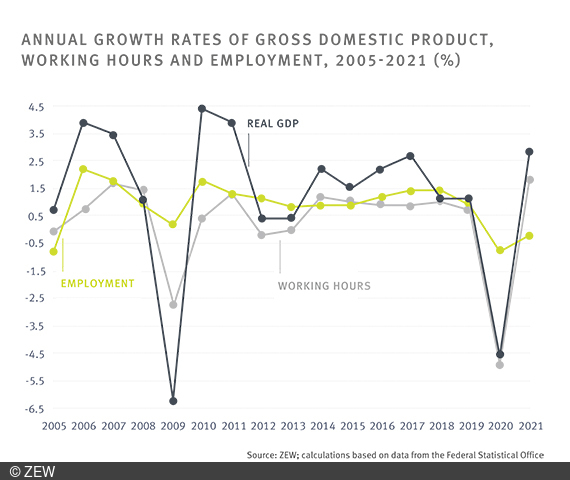The Resilience of Labour in Times of War
CommentAs a result of the war in Ukraine and the Western sanctions against Russia, energy and commodity prices are rising. Goods for daily use are becoming more expensive, and oil prices are rising rapidly, as are inflation forecasts. Companies in the chemical and logistics sectors, for example, which are directly affected by the price increases for gas, oil and other raw materials, are adjusting their business models. Labour costs are falling with unexpectedly higher inflation rates and constant nominal wages. This has a temporary stabilising effect. Also, more people are employed in the defence industry, in energy conservation and alternative energies. However, aggregate demand for goods may decline as people begin to prioritise which goods they need and which they can do without if prices continue to rise.
Depending on how long the war and sanctions will last, further price increases and more extensive economic disruptions cannot be ruled out. Current developments directly follow the economic slump caused by the COVID-19 pandemic, which has not yet been fully overcome, and a (moderate) decline in overall economic activity in Germany, which had already begun in 2019. Global trade conflicts, Brexit and a slowdown in growth in China have further fuelled this development. Despite this, the labour market has proven relatively robust so far – apart from the fact that up to seven million people were on short-time work in mid-2020. At that time, short-time work largely prevented the threat of unemployment due to the closing of clubs, trade fairs, sports studios, hotels and restaurants in Germany.
The links between economic activity, employment and the volume of hours worked
In light of the current uncertainty caused by the war, policymakers and economic experts alike are asking themselves what the future outlook for labour will be. There are plenty of models and scenarios for estimating future developments. The German economic research institutes and the Council of Economic Experts regularly publish new forecasts focusing primarily on estimating economic development. If the economy falls into a recession, this will also have an impact on employment.
Looking at the relationship between the evolution of economic activity, employment and the volume of hours worked in Germany from a historical perspective based on macroeconomic variables shows that these three factors are closely interwoven. A glance at the recent past may be helpful to understand how resilient employment could be during the ongoing war in Ukraine, and how resulting changes may permeate the economy. The figure shows the relationship between the annual growth rates of gross domestic product (GDP), employment and working hours for the period 2005 to 2021. In these sixteen years there were two recessions: in 2008/09 as a result of the banking and housing crisis in the USA, and in 2020/21 as a result of the COVID-19 pandemic.
During this period, real economic activity (GDP) grew by an average of 1.25 per cent per year. Strikingly, however, there is a considerable annual fluctuation of growth rates between minus 6.2 and plus 4.5 per cent. The negative swings are the result of unpredictable economic shocks, including the real estate crisis, the pandemic, and a contemporary shortage of raw materials and increased inflation.
The changing rates of employment tend to follow the changing economic activity. However, the fluctuations are more moderate (between plus 2.2 and minus 0.8 per cent). The average growth rate of employment was 0.88 per cent per year. What is also important for the connection between work and the economy is how many hours those in employment work. The total volume of working hours in the economy grew, on average, by 0.3 per cent per year i.e. less than the growth rates of employment and GDP. From a macroeconomic perspective, more people in employment contributed to economic output, but on average the working hours per person declined. The lower growth rate of working hours is primarily due to education and innovation, both of which contribute to efficiency gains.
In summary, the macroeconomic analysis shows that, on average, roughly one per cent economic growth per year is necessary to keep the volume of working hours constant. If growth falls below one per cent, working hours decline. If growth continues to fall or there is a prolonged recession, employment will also start to decline.

